Holiday seasons are usually a sign that it’s time for the fun and games to begin for eCommerce businesses. Why?
Increased sales!
Yep, the run-up to a major holiday like Christmas and Easter is a boom time for eCommerce.

Holiday seasons are usually a sign that it’s time for the fun and games to begin for eCommerce businesses. Why?
Increased sales!
Yep, the run-up to a major holiday like Christmas and Easter is a boom time for eCommerce.

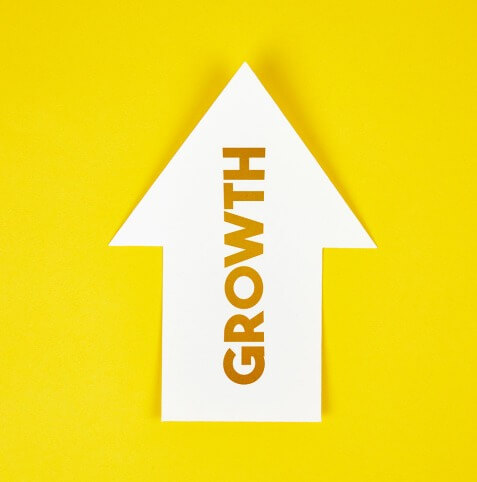
Ecommerce has been a big winner in recent times, with UK eCom sales increasing from 19% to 38.6% of all sales from 2018 to 2019. The festive season is a particularly good time for eCom, with a reported increase of 23% in direct online sales in December 2019.
If you need any more convincing that marketing during holiday seasons is important, consider this: in the UK in 2019, eCommerce accounted for 28.2% of all retail sales during the Christmas holiday season. That’s almost £28 billion in online sales in the space of two months!

But…
Let’s face it – 2020 hasn’t been a great year. We’ve all been affected by the worst pandemic for decades. Covid-19 has torn the fabric of our global society apart, leaving social and economic turmoil in its wake.
The good news is that this situation has led to more consumers than ever buying goods and services online.
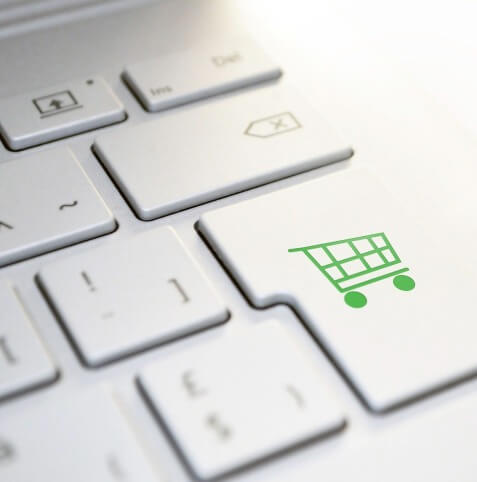
The bad news is that eCommerce has become a much more competitive landscape, mainly due to many of the big high street retailers turning their attention (and large sales and marketing budgets) to online sales. This has driven up the cost of ads. Also, consumers are getting more and more accustomed to seeing amazing deals and slashed prices online.
With money tight due to the impact of Covid, eCommerce businesses are having to fight harder for each penny spent, which is inevitably hitting profit margins.
So, how can you plan to overcome these challenges and make holiday seasons a success? The answer lies in effective marketing.
This super-detailed guide to eCommerce holiday marketing will give you direct guidance on how to market your goods and services to maximise sales. We’ll guide you on how and when to focus your marketing efforts in the right areas, so you can make the most of these critical spending seasons.
This includes little-known tips and secrets to planning an effective holiday season marketing strategy and implementing it at just the right times.
It is the best of times and the worst of times for eCommerce right now.
A surge in online shopping has been countered by more sellers setting up shop and a significant increase in advertising costs. To illustrate this, the cost-per-engagement of Facebook ads has risen by 13% over the course of 2020.
Increased costs of this size are guaranteed to put pressure on any eCom business that relies on advertising to drive traffic and sales.
One way to overcome this problem is to increase sales through marketing efforts which have larger reach than paid ads and can work out considerably cheaper per customer engagement.
But – with so many marketing strategies and channels out there, how do you separate the wheat from the chaff? In other words, how can you zero-in on the strategies that will move the needle and increase your sales, especially during crucial holiday seasons?

First you need to get prepared. Of course planning ahead is the way to go, but there’s often improvements you can make right up until (and even during) a holiday season!
The sooner you start to plan your marketing efforts for the holiday seasons, the more successful you’ll be. Leaving things until the VERY last minute is never a good idea!
This is especially true when it comes to the holiday seasons. Apparently, 40% of consumers begin their Christmas shopping before Halloween. But don’t fret if it’s already November and you haven’t started yet (same for any major holiday) – it’s never too late with the right support. You can still implement some effective strategies, and let’s face it, starting a late holiday marketing campaign that hits the right notes is definitely better than a deafening silence.
If you are starting your planning late, it’s a good idea to allocate a dedicated team or an experienced eCommerce agency to focus your efforts and get better outcomes.
So, what should your plan look like? Here’s a rough outline of what you need to do:
Here are a few ideas of tools and ideas you can use to work out which products will fly off the shelves if you market them right:
Use this tool to find out what products people are searching for on Google (for more information on using Google Trends check out the eCommerce SEO Section below).
Look over your customer feedback and reviews from recent months and any requests for products that have come up regularly.
Simply type Amazon best sellers into Google and you’ll find a link to the Amazon best selling products page which lists the highest selling items listed by category.
for items that went out of stock last year. Check your stock inventories from the holiday periods last year and look for popular items. This will help you to plan for extra stock and find back-up suppliers if needed.
If two or more similar or related items stand out as potential good sellers, consider creating product bundles.
Also think of ways that you can label or describe other products (not necessarily excess stock) to entice more holiday sales. Consider segmenting your stock into “ideal gifts for him” or “ideal gifts for her” or “ideal gifts for the kids”, etc. if possible.
The next step is to make sure you create a schedule of the important dates (or holidays that resonate most with your eCom biz) over the coming months. Depending on which country you sell in, you might want to include the following:
Don’t forget to include other religious and cultural holidays such as Diwali (November 14) and Hanukkah (December 22nd to December 30th), as these could also be BIG opportunities to increase sales.
Planning a schedule for your marketing campaigns is essential.
Let’s say you decide that Easter is going to be one of your biggest opportunities to increase sales. It’s no good planning to start your campaign a few days before the main event. You want to build awareness, create anticipation, and get people fired up to buy in advance. So, you would be best to schedule in your marketing efforts to start ‘at least’ one week prior to Easter, with awareness building, then creating urgency as the date approaches.
A good approach is to create a repeatable calendar of key priorities that you can use each year. For example:
But, what many eCom businesses fail to do is factor in the pre-campaign preparation and anticipation building. It’s recommended that you include things such as:
It’s no good just saying, “Right, we want to increase sales on this holiday or over this holiday season.” Using the SMART goals you could change this objective to: “Increasing sales of a certain item by a minimum of 500% on Boxing Day.”
This ticks all the SMART goal boxes!
SMART goals can be used for setting expectations not only for your sales but also the marketing campaign itself. For instance, you can have a SMART goal for your email marketing performance, organic traffic, and so on.
Once you have a plan and schedule in place, the next task is to make sure that your website or shopping portal is holiday ready. This can seem overwhelming, right?
There’s so much to do, with so little time…
The best piece of advice we can give you is to break it into chunks and prioritise your tasks.

You also need to make sure that your site is technically ready for a surge in traffic. The holiday season could be the most profitable period for your online store. Don’t let a poorly optimized website lose you valuable holiday traffic. You don’t want slow checkout processes causing customers to abandon their carts!
If you follow the advice in this guide, you can expect a spike in traffic when you run your marketing campaigns. The last thing you want is your website or checkout crashing due to demand!
If you’re not a techy person, ask your web developer or host to check the following:

Finally, you should do several run-throughs of your customer journey. Identify pinch points, any confusing options, or other off-putting elements and seek to rectify them before the holiday period begins.
The customer journey is super-important. If there’s any kind of friction or slow-down in the journey, people will look elsewhere.
Each stage of the customer journey requires a “conversion” to the next stage. If people are not being converted at any point, this is known as a “funnel leak”.
A good customer journey will flow through the funnel stages without interruption or hassle. The stages of a funnel are shown in the diagram below.
In a nutshell, this is how a good eCommerce customer journey looks like. First, customers become aware of your brand after they identify a purchasing need and are browsing the internet to find the best option for their needs (interest). They will evaluate pros and cons of each option (which usually means comparing you with your competitors) and only then will make the purchase decision.
As a brand, you should continue engaging with your customers after the purchase so that they continue buying from you and become brand advocates.
On the other hand, a poor customer journey will have obstacles or snags along the way. This could include things like:
Ads displayed in the wrong marketing areas or delivering an unclear message might attract the wrong audience (or no audience at all!)
It should be quick and easy for people to sign up to a newsletter or email list. Don’t ask for too many details, just a name and email address will do. This increases your overall conversion rate and encourages repeat purchases.
Landing pages that are difficult to navigate and poorly designed checkout pages are common mistakes made by eCommerce sites. Your design has a huge impact on all stages of your customer journey.
There are countless other things that can create a poor customer journey. Make sure you are constantly monitoring your website performance and campaign metrics to identify any issues. Busy holiday periods are actually best times to test as your customers flock to your site. There’s no better time to be testing and observing site traffic then when it’s at its peak.

Now is the time to get into the nuts and bolts of your overall marketing strategy. The problem is – there are so many factors to consider.
The online marketing landscape can be confusing. Which channels should you use? Which strategies yield the best results? How many campaigns should you run? There’s no simple answer to these questions.
One thing is for sure, however. You need to avoid the common pitfall of putting all your eggs in one (or maybe a few) baskets.

Unsuccessful eCommerce marketers will rely on only one or two strategies or channels, such as paid ads or blogging.
What should you do to be successful?
Diversify.
You need to build a marketing strategy for paid, owned and earned media.
Paid media can include paid ads on social media sites such as Facebook, LinkedIn or Twitter. These ads can drive traffic to your website or other content that promotes your products. Facebook works on an auction basis, so the price to target certain audiences may vary depending on their popularity and availability.
Another form of paid media is paying popular influencers or industry authorities to promote your products through their channels. This could be in the form of YouTube videos, blogs, or podcasts for example.
Finally, you can also use search engine ads to attract the right target audience. This can be a valuable way to increase traffic and conversions.
Owned media includes web channels that you own or display your unique branding. In other words, it is any web presence that you have some or complete control over.
In general, there are two types of owned media – fully-owned media (you have complete control) and leased-for-free owned media (you own the content, not the channel).
The most common example of fully-owned media is a company website. With your own website you have full control over the content, design, branding, and UX. If your website has a blog attached to it, this is media that is fully owned and controlled by you too. Email lists are another example as you own the list and can control the messages you send to them. Even if you get banned by an email automation tool such as Mailchimp, as long as you have a back-up of your email list, you can simply migrate to a different app. The list is yours. End of story!
YouTube channels and social media groups or pages are examples of not owned media that you don’t fully control. They can be seen as extensions of your website and brand, but you are at the mercy of the platform. For instance, they could decide to change their search algorithms or implement a policy change means that you’re no longer welcome.
Reliance on SEO can also be seen as temporarily owned media, as you do not own your rankings. Multi-million dollar sites have been hit by Google penalties and frequent algorithm changes. In other words, you can lose your search ranking in the blink of an eye.
To sum up, the more owned media you control, the bigger web presence you can command. Increasing your owned media will also give you a bigger launchpad for your marketing campaigns.
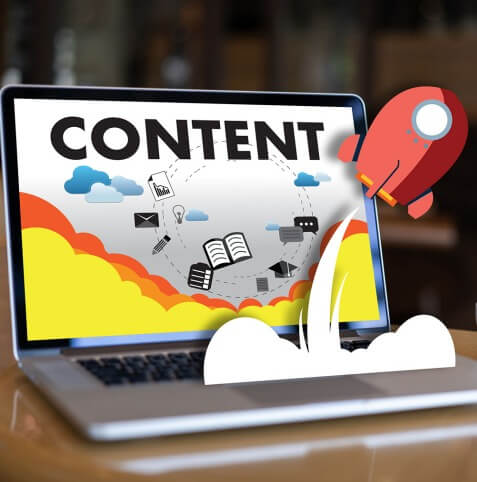
To put it simply, earned media is web-based “word of mouth”. This encompasses things like viral posts, social media shares and likes, reviews, recommendations, guest blog posts.
It also includes inbound links. Your web presence can be enhanced by strong backlinks earned by, say, shit-hot digital PR campaigns. This is why it’s so important to have engaging, shareworthy and valuable content. This can be in the form of blogs, videos, podcasts, press releases, downloadable e-books, etc.

In other words, earned media is all about creating a buzz about your brand and getting your content shared to increase your SEO ranking and drive more traffic to your eCommerce site.
We will look at these different types of media and how you can run marketing campaigns on each of them in a moment. But first, let’s quickly revisit your customer journey (you might want to take a second look at the funnel image in the section ‘Ensure your website is holiday-ready’.

Let’s suppose you sell travel packages online. You could attract your audience with a Facebook ad redirecting them to a series of blogs on popular holiday destinations for the winter months. At the end of each blog post, they can opt in to download a special holiday guide. You can then use an email marketing campaign to make them aware of special offers and deals throughout the holiday period.
You engage with your audience not only before but also after the purchase. And continue remarketing to visitors and customers to encourage repeat purchases.
Smaller ticket items may use a shorter funnel. It could even be as short as a targeted paid ad that leads directly to a special offer in a landing page. From there the copy and presentation of your product will help convert prospects into customers.
The most important thing to get right is the content at each stage. You need to make sure that it’s both engaging and that it communicates your sales message. The tried and tested techniques below help you increase conversions:
Triggers
Use triggers to identify and define customer behaviour and generate cross-channel marketing to re-engage people, such as targeted emails or direct messaging.
Automated Messages
Send automated messages to re-engage people that have left your site mid-flow.
Drip Campaigns
Create automated nurture or engagement email sequences to link back to your funnel.
Web Analytics
Use website analytics to monitor things like bounce rate, average order value, time on site, etc.
Now that you have a clear understanding of how your sales funnel looks, it’s easier to identify which channels you should be using at each stage. Let’s take a look at some ideas to attract and convert customers and how to continue engaging with them after the purchase.
Getting visitors to your website is the first phase of the sales funnel.
It’s not easy though. Competition is already high and during the holiday periods it will be even higher. Paid ads are expensive, especially during the holiday seasons.
However, you’ll struggle to beat the competition if you only use your owned media presence.
In fact, the only way you’re going to beat the competition in today’s crowded marketplace is by applying a combination of paid, owned and earned marketing strategies. Using all 3 types of media effectively will maximise the number of people you drive to your website.
When it comes to holiday season advertising, the key is often to communicate your special offers in a fun and enticing way. But it’s not all about the creative part – poor campaign management is directly responsible for a bad ROI. Wrong targeting, lack of A/B testing, bad reporting… There are multiple ways you can screw up your paid marketing campaigns.
Let’s take a look at some good practices:
Let’s take a close look at a few high-performing holiday season ads from eCommerce brands from recent years and analyse why they work so well.
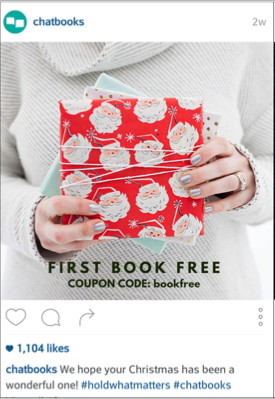
Instagram is a highly visual platform. Ideally, your audience should understand what your ad is about in the blink of an eye. Chatbooks is redirecting users from Instagram to their website by promoting their Christmas coupon code. Who doesn’t want a free book anyway? This ad is simple yet it doesn’t only do a great job at advertising the campaign itself but also raising brand awareness.
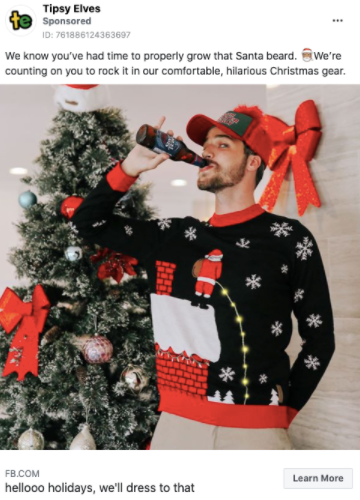
This Facebook ad from Tipsy Elves is a great example of a funny and catchy campaign. The copy works well to grab attention by letting customers know that they have humorous and unique Christmas jumpers for sale. It also speaks to their target audience and the ad headline explains in a short sentence what their brand is about.

This ad from ASOS is a great example of using a social media platform’s strengths. ASOS’s ad uses a striking image to catch attention. The text copy alongside the ad is brief, clear, and to the point, communicating the 20% off everything Black Friday deal without any padding. The blue heart emoji is a nice touch too to reinforce the theme of the ad image.
One thing that all the ads shown above share in common is that they have been designed really well, they clearly communicate compelling offers, and highlight certain products that are big holiday sellers effectively.
With most social media platforms, including Facebook, you can set up and schedule your ad campaigns in advance. We recommend that you take advantage of this and ensure that everything is scheduled at least two full days in advance. The reason for this is that it sometimes takes up to 48 hours for Facebook to approve ads, especially during the busy holiday periods.
Here are a few tips to make your ad copy more effective:
Remember that the tips above are also valid for search engine ads. And since we are talking about them…
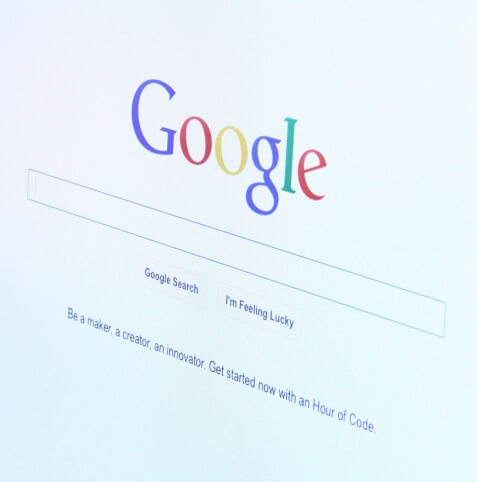
No section on paid media would be complete without mentioning search engine ads. This section covers ads on Google, Bing, Yahoo, etc. Obviously, Google is the big player here, but it is worth considering placing ads on some of the smaller search engines too to pick up more niche markets.
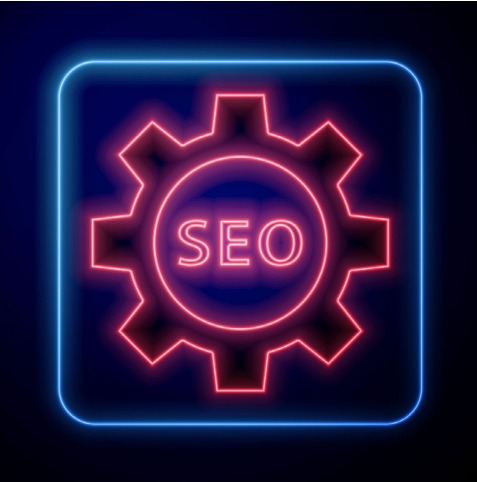
The most important factor for a successful PPC strategy is to choose the best keywords within your budget. You can use Google Adword Keyword Research Tool to find the keywords with the highest search volume, with the cost per click displayed alongside.
As you are looking to maximise sales over the holiday season, you should look to bid on seasonal keywords that are related to your products. For instance, if you sell clothing, you may want to bid on “Christmas jumpers” or “knitted Christmas sweaters”.
The timing of PPC ads is also crucial. It’s worth realising that a lot of people leave their holiday shopping until the last minute with 40% of holiday sales occurring in the 10 days immediately before Christmas. In other words, make sure you schedule in some of your PPC ads for the week before Christmas Eve.
Don’t ignore this type of paid media. Retargeting is a super-effective way to drive traffic back to your website. Retargeted ads are focused on re-engaging people that visit your store, but didn’t buy, as well as previous paying customers.
The main reason is that most people need to be exposed to a brand several times before buying. Salesforce revealed that people need at least 6 to 8 touches with your brand before having the confidence to buy something. The best way to encourage these multiple engagements with your brand is to target people that have already visited.
Retargeted ads can also be used effectively for cart abandonment scenarios. For instance, you can set up retargeted ads to appear on Facebook news-feed, Facebook sidebar, Google, and Instagram sponsored posts, every time someone adds an item to their cart on your website. After all, if they liked one of your products enough to add to their cart, chances are that the ad will entice them back if they leave.
Getting “free” traffic is the holy grail of marketing. It’s challenging, but achievable. The trick is to not view it as entirely free. You’re going to need to put quite a bit of time and effort into it, and let’s face it – nobody views their working time as “free”.
By creating a strategy to build and use earned and owned media, you’ll be able to take advantage of the fruits of your labour later on down the line, especially during any holiday season.
Ok, let’s state the obvious first – earned and owned media strategies can save you a lot of money as you don’t have to shell out for paid ads. This is especially important in the holiday season when ad costs go through the roof.
But there are lots more subtle benefits to concentrating on earned and owned media:
More control
With paid ads you’re at the mercy of another platform’s algorithm and processes. In other words, you can’t control how and when your ads are going to be seen. With earned and owned media, you have more control over how your brand will be perceived and where people go after seeing your content.
Better analytics
Owned media allows you to track the metrics you want and analyse the data. Google and Facebook ads allow you to measure and keep some data, but not all of it. This means you may miss out on important insights as to how effective your promotions are.
Get ahead of the competition
It’s true that most companies have a mixture of paid and owned media, but the majority take the easier route of simply paying for most of their promotional advertising and marketing. If you put some effort into building earned and owned media, it’ll put your brand in front of more eyes and you’ll outperform your competitors, especially at crucial times of the year such as the run-up to Christmas.
Email lists are a goldmine
Don’t listen to the naysayers – having an email list and a good email campaign is still one of the best ways to promote sales online. This is even more true when people stay at home more – during the lockdowns of 2020, 78% of marketers witnessed a surge in email engagement. In other words, don’t neglect email promotions during the holiday season! As a side note, make sure you backup your email list within the rules of GDPR as you don’t want to fall foul of the authorities and risk having to deal with a high unsubscribe rate.
So, yes, earned and owned media are EXTREMELY important.
But, it’s best to strike a healthy balance between paid and earned/owned media. The ideal situation is to have techniques and workflows in place to shift people away from paid media, over to earned and owned media. In other words, a typical journey could be:
Facebook Ads -> Landing Pages or Blog Posts -> Email List
During the holiday periods, you need to make sure that your SEO is tip top. Even though it takes time to start seeing SEO results, you can still do things that have an impact short-term. But if you create the right pages, you can set up seasonal pages to benefit the site in future years – this year is just the beginning! Let’s take a look at a few tactics you still have time to implement:
Public relation strategies become more important than ever. People generally start to switch off from work and responsibilities in the run-up to Christmas, which means they spend more time online reading blogs and news items or watching YouTube influencer videos.
You can capitalise on this by sharing details of your campaigns and offers with bloggers and journalists. This will increase the hype around your brand. A good idea for piquing the interest of journalists is to offer stat-based content. For example, if your eCommerce business sells fashion items, you can create a guide on which fashion items sold the most last Christmas. It makes for easy, eye-catching headlines for news items.
Working with Charities
Christmas is the season of goodwill to all, so why not use it as a chance to donate to some worthy causes? You can engage people by involving them in fund-raising events and promising to match the amount raised for example.
Promote your Bestsellers
Bloggers and journalists love to publish lists of holiday gifts. Include stats of sales or popularity of certain items from previous years and send them out as press releases.
Sharing the Love
Encourage your customers and social media followers to share feel-good stories, then share them with blogs and news channels. Everyone loves a good uplifting story during the holidays!
Storytelling!
Get ideas from your employees. Maybe they have a story to share or they have done something newsworthy in their community. As well as promoting your brand, you’ll also build stronger relationships with your staff. Win, win!
During the holiday seasons you want to join in with the atmosphere of fun and joy, especially when it comes to your social media posts.
To do this effectively, it’s a good idea to liven up your posts so that they offer something different. Rather than dry sales posts, why not try a few of the following ideas:
Whether this is something you do all year round or not, you should definitely consider some affiliate marketing during holiday seasons. With more people spending time online at this time of year, you can increase your sales by bringing some affiliates on board.
Affiliates are bloggers, review websites, influencers, niche websites, that are related to your product in some way and agree to promote your product in return for a small commission on the sale. All you need to do is set up an affiliate program using one of many affiliate apps available out there such as Refersion or LeadDyno. Then approach relevant potential affiliates with an offer and entice them to sign up.
If you already have affiliates on board, a good way to get them to promote your holiday deals is to run a seasonal affiliate contest. For example, you could offer prizes to the top 3 highest earning affiliates during holiday periods.
The key takeaways here are:
The next section will look at the next part of the funnel – how to convert visitors into paying customers.
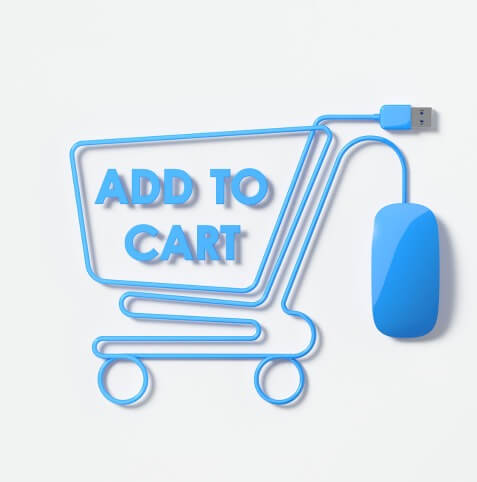
Any ideas what the biggest and most common mistake eCommerce sellers make?
Focusing too heavily on generating traffic to their website and not enough on converting those visitors to customers or getting them to sign up with their emails.
Optimising the rate at which visitors convert to paying customers is even more important in the holiday seasons. Why? Because ads are more expensive at this time of year, which means profit margins are lower. To counteract this, you need to increase the amount people spend.
In other words, you need to use methods to convert more of your website traffic and increase the average basket value to drive higher profits.
To clear up any confusion, there are a few different types of conversion for eCommerce – actual sales, adding products to cart, email sign-ups, social media shares, etc. Basically, anything that involves the website visitor taking a positive action can be considered a conversion, as it keeps them in the sale funnel and can ultimately help to boost sales.
Therefore, the conversion rate is the percentage of people that take an action determined by the KPI’s that you deem to be important – sales, email sign-ups, products in cart, etc.
Average eCommerce conversion rates are between 1 and 2%.
1 to 2% may seem like a small amount, but if you are getting tens of thousands of site visits per day or more, this can lead to a healthy profit. With the right approach and strategy to conversion rate optimisation, you should be setting your sights on 2% or higher as a target rate during the holiday periods when people are primed for buying.
There are plenty of third-party apps and tools that you can use to measure conversion rate accurately. Google Analytics does a pretty good job and is free to use, as long as you only want to implement the basic features and metrics.
Once you know what your current conversion rate is and you have a system set up to monitor it, next you want to start implementing some techniques to boost conversions.
It is vitally important to capitalise on creating extra conversions while people are on your site, as this will make the difference between ‘revenue increase but profit decrease’ and ‘revenue AND profit increase’, which is important for long-term profitability.
Here are some examples of methods that will help you to optimise conversions.
We’ve already mentioned email marketing a few times in this article. By now, you may be asking “Great, but how do I build a decent-sized email list?”
Well, here’s some good news for you. Our team of expert digital marketers have put their heads together to come up with this exclusive guide to building an email list and how to use it.
Why build an email list?
It makes good sense for any eCommerce business to try and migrate people away from earned and paid channels (ads, social media) onto owned media (email, SMS lists).
Owned media gives you more control and you don’t have to rely on algorithms that are open to constant change. Also, there is the ongoing cost of running paid media marketing campaigns. Additionally, the cost of digital advertising increases in the holiday season. If you have grown a healthy email and SMS list earlier in the year, you can save a considerable amount on advertising costs.
Another good reason to build an email list is that it’s always easier to sell to people that have already bought from you. They are already engaged with your brand, and as long as the experience was good, they will trust you. You have access to some of their information, preferences, interests, etc. Therefore, you can send targeted emails that tap into their desires and offer discounts or deals that appeal to them.
How to build an email list
There are numerous ways to build an email list. Obviously, you need a way to capture people’s emails using a sign-up form, pop-up, or simply a capture field during checkout.
A good strategy is to implement multiple ways to capture email addresses.
You could offer a discount coupon that people receive in their inbox for example. Another way is to offer a “lead magnet” which is a free downloadable product such as a guide, report, or other valuable content, in exchange for a valid email address. Finally, you can offer a free subscription to an email newsletter that keeps people up to date with all the latest news and offers from your brand.
Successful email marketing is all about engagement.
Unfortunately, most eCommerce businesses get it wrong. The two biggest mistakes are either over-complicating things with “high-concept” marketing ideas or making the copy too long or boring.
First, you need to catch people’s attention. This isn’t easy when most people are receiving 100’s of emails in their inbox each day. You need a strong subject line to get people to open the email in the first place. A good subject will convey the content of the email or highlight the offer you are making.
Use strong verbs such as “get” or “grab” at the beginning of the subject line to create urgency and inspire action. For example, “Get 10% off all items for the next 24 hrs!”, or “Grab these bargains now!”.
The body copy of the email should also be straightforward, conversational, and clear. Make sure the offer is front and centre of the body and is highlighted in any image that you use.
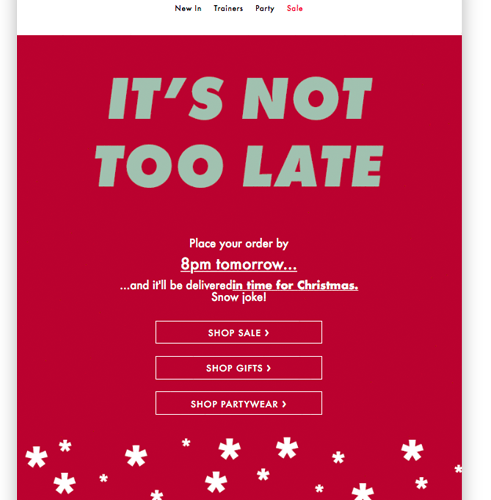
Consider this classic, simple, yet high-performing Christmas deals email from ASOS which has a bold offer and ticking clock to generate urgency:
Another good tip is to use special email designs during the holiday season or include emojis related to the holiday in your subject lines to get attention.
This section will help you understand the types of marketing email that you can send and which ones to use.
Remarketing emails
These emails are designed to encourage existing customers to go back to your website and purchase again. The offer can be a discount coupon, a free gift, or announcement of new stock. Remarketing emails can also be a good opportunity to offer an upsell. For example, you can send a discount code off sports equipment for someone that has just bought training shoes.
Follow-up emails
Typically used with an automation tool such as Mailchimp or HubSpot, you can send out one or a series of follow-up emails to keep buyers engaged with your brand. A sequence may include a “welcome” or “thank you” email after signing up, or a post-purchase email for paying customers.
Information or Content emails
You can send nurture sequences that offer valuable information or tips. These can be like a series of blog posts. The idea is to keep people engaged and interested in your brand and begin to associate it with good value. These may not directly boost sales, but they can increase your brand reputation.
Announcement or Offer emails
You can send news of a new item or range of items that you have recently started stocking or are due to be released. If you are running a sale or special discounts on Black Friday or in the New Year, for instance, you can make them aware in an email and send reminders in the lead up to these days.
We’re living in a time of momentous change.
Covid-19 has changed the global landscape in many ways, not least in the way we shop. It has also changed the way people shop online.
For a start, more people are shopping online, which is good news for eCommerce. The not-so-good news is that competition from brick and mortar businesses moving online and more people looking to set up eCom businesses from home has grown. The net effect of this has been increased advertising costs, meaning lower profit margins, and a change in online shopper’s expectations. They are now expecting the best deals and lowest prices, combined with fast delivery and the best customer service possible.
In other words, eCommerce business owners are having to fight harder than ever before for each dollar, pound or euro spent.
Our advice is to plan for a strong holiday season in terms of sales, but a more competitive environment, which demands a solid marketing strategy. And if you haven’t planned ahead, the good news is there are always lots of improvements you can make right up until a holiday season! And possibly even during!
Ok, so we know why things are different this year. But what should you do differently this year in terms of marketing?
Here are a few top tips to get your marketing on track for the unique opportunities and challenges of the 2021 holiday seasons.
Although you’re planning as early as possible, you need to be prepared to change. We’re in a new era for online shopping. The rules and best practices are changing constantly so don’t be too rigid. Be ready to change direction if needed as you monitor the success of your campaigns.
Use the holiday seasons to be more creative with your message. Make it more fun and fitting with the season. People are desperate for light relief and distraction from the doom and gloom in the news. This year is a good time to aim for different audiences and markets. Bear in mind that social gatherings will be different this Christmas, and you can incorporate that into your marketing messages.
You need to allow time for PPC ad optimizations. Also realise that cost per click (CPC) and cost per thousand impressions (CPM) values are likely to be higher this year and may need close monitoring to ensure a good ROI. As soon as you have your marketing assets ready, start running your campaigns to have enough time to optimize them.

Easter Sunday falls on April 4 in 2021. This means that you only have 4 months after Christmas to prepare for Easter, which is one of the top three holidays in terms of eCommerce sales.
Get a head start on your competitors this year by planning your Easter ad and marketing campaigns early.
Easter Sunday falls on April 4 in 2021. This means that you only have 4 months after Christmas to prepare for Easter, which is one of the top three holidays in terms of eCommerce sales.
Get a head start on your competitors this year by planning your Easter ad and marketing campaigns early.
Promote a fun Easter campaign on social media – giveaways, competitions, online Easter egg hunt, etc. Don’t be afraid to be creative and show off your silly side! A great social media campaign has some personality to it, and Easter is the time of ridiculously cute fluffy animals and chocolate! Fluffy animals) always go down well on social, so make sure to have some fun and show off your brand personality and human side.
Tweak your website design to include Easter-related imagery to put your customers in a shopping mood. Don’t forget to tweaking your landing page copy as well to ensure the messaging is consistent. This will not only improve user experience, but also your quality score, and in turn improving your ad position, leading to a lower CPC.
Your most valuable customers are the loyal ones. As well as your website, give your emails/newsletters a touch of Easter flair too.
Create an Easter egg hunt on your website to encourage interaction and fun. This is a clever way to offer a discount to your customers. Even more genius is the fact that customers will have to scan through your entire website to find them and check out certain pages that they might not have visited otherwise.
Research products that are popular at Easter and promote them. BUT you don’t have to sell Easter products to make the most of the holiday! The four day weekend alone can be an incentive to spend, so encourage customers to spend with you with special Easter promotions.
Or, why not combine products together to create your own Easter basket for your customers to make an easy purchase.
Use retargeting and remarketing campaigns in the run-up to Easter. Shoppers that have viewed your product pages all have high buying intent and so retargeting these users will be very cheap, yet highly effective at driving sales.
And get the puns in! We all love an egg-cellent pun, right? Check out this list of Easter-themed puns to incorporate into your copy.
Schedule! During these popular holidays, make sure to schedule your content strategically ahead of time. Check your Twitter analytics and Facebook insights to see when your best times to post are for maximum engagement.
Then with the right Easter marketing campaign, at the right time, you’ll see eggs-tra sales and revenue!
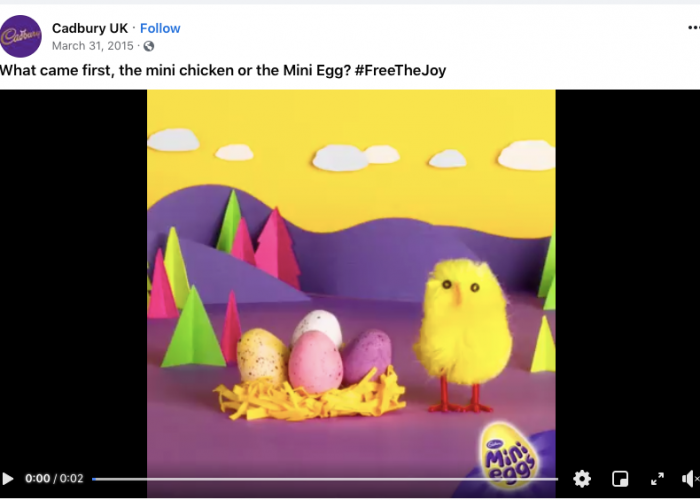
Cadbury UK did a great job of showing their silly side with their #FreeTheJoy campaign where they simply uploaded a 2 second video of one of those classic fluffy toy chicks jumping up and down next to some mini eggs, along with the caption; “What came first, the mini chicken or the mini egg?”. It was very simple, very cute and very effective, with over 1700 likes and 254 shares on Facebook.
After Christmas, Easter and Thanksgiving, Halloween is the next most popular holiday, with the UK Halloween market worth, as of 2018, sitting at a comfortable 419 million British pounds! This makes it a great opportunity to boost sales if you get your marketing right.
Here are some ideas to get your Halloween marketing on-point.
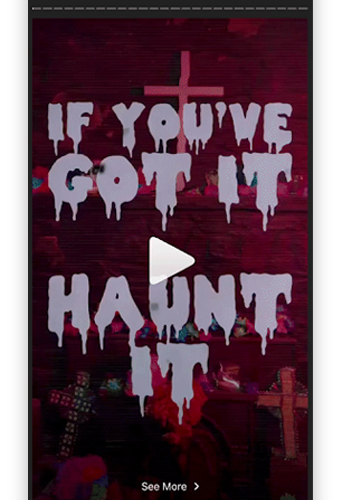
Online clothing store Fashion Nova nailed it with their multi-channel Halloween marketing campaign which included a spooky website theme, Halloween themed products, and a spooktacular video:
With everybody jumping on the Black Friday bandwagon, you need an A+ marketing campaign to get things moving.
Now, more than ever, your offer will make or break your campaign, due to rising customer acquisition costs and the increase in competition from other eCommerce retailers. Grabbing attention with a great offer and ad campaign is essential!
Here are some tips to make the most of Black Friday:
Create smart content to promote your Black Friday deals. Aim for a mixture of organic SEO traffic and paid ads to drive up sales.
Increase brand awareness in the run-up to Black Friday! Gift guides with sale-offers displayed are a good example of content that is shareworthy and will build awareness.
AVOID site-wide blanket discounts. Black Friday Cyber Monday (BFCM) has become more than just a 4-day weekend sale. Many retailers now spread out their campaigns right up to Christmas. Avoid the temptation to just apply a 50% discount across the board. Many eCom sellers already do this throughout the year to build their email list. It can hurt your profit margins if you go all-in on BFCM as advertising costs go through the roof.
Go for the “buy more, save more” approach. Instead of the blanket discount model, try something like “Get 25% off if you spend over £100”. This way you capitalise on your ad spend by encouraging a higher average order value.
Smart planning. If time is against you, use smart, achievable goals to maximise your chances of success. It shouldn’t take more than a few days if you’re focussed! Use previous store performance data to inform your revenue goals. Then work out how much revenue you should generate each day to hit your goal. You can then calculate the top-of-tunnel traffic you need and also the traffic mix from various predictable sources.
Set your ad budget and stick to it! From your revenue goals, you can work out your budget. With ad costs high, make sure you don’t exceed the amount you need to reach your goals.
Set a target profit on each order. From your ad budget and revenue goals, you can calculate how much profit you need on each order to zero-in on what your offers and deals will look like. Take into account your production and supply costs, combined with ad costs, to work out how much you can profitably discount your goods. You may need to bundle items together to maximise profit. Or you may discover that you can discount certain products more than others.
Create daily deals. To keep the momentum going through the sales period running up to Christmas, you should think about extending your Black Friday/Cyber Monday campaign for a week or more. To keep people interested throughout the sale period, you can offer different deals on one-day flash sales. Make sure you build anticipation for these by sending out emails, using promo banners, etc. which announce the upcoming deals or hint at what they might be.
Offer extra services. Many eCom retailers offer extra services on Black Friday to make gift-giving easier. Gift wrapping, Christmas messaging, personalised cards, & target delivery dates, all make life easier for the customer and can be sold as one-click upsells at the checkout.
Gift card incentives. An interesting alternative or addition to discounted goods, is to offer a gift card for purchases over a certain value. This is appealing to the customer as they can then give the gift card to somebody else as a gift, which means you potentially get a new customer to boot! (Note – Shopify now offer gift cards across the board).
Mystery bundles. People love a good mystery. It taps into the curiosity part of our brain that creates a strong drive to solve the mystery. You can offer the mystery bundle as a free gift for larger purchases, or just sell it as it is. Just make sure that you target your mystery bundle to the correct market – you don’t want bundles of complaints from disappointed customers!
Gamify your offers. Gamification means using something like a “spin to win” wheel to apply offers. In other words, people play some sort of game to win special deals such as 25% off orders over £100, or free gift with a certain purchase, etc. You could run these alongside a traditional offer, as an extra perk, so you don’t exclude people who don’t want to take part in a game of chance.
Partner up. At this time of year, other brands & influencers are also looking to promote themselves. You could approach influencers in your niche about promoting each other. For instance, you could include images and quotes from a well-known influencer in your promos, with links to their content, so it’s a win-win for both parties.
Be charitable. Finally, Christmas is the time of good-will to all. So why not use it as a time to make a donation. You can use your increased sales and profit margins on Black Friday to announce that you’ll donate 2% of all sales to a good cause, for example.
Here are some practical ideas to generate interest in your Black Friday sale and make sure you’re prepared for it:

Holiday gift guides really are helpful for the busy holiday shoppers and extremely successful in driving holiday sales when they are used in the right format and displayed at the right place and time.
Black Friday is the ideal time to release a gift guide. For example, Trouva tapped into the eco-friendly market on Black Friday by publishing and promoting their “Gifts with a Conscience” guide.
Done right, gift guides will resonate with your shoppers and motivate them to purchase during the busy holiday season.
This example of a great Black Friday website from SHEIN includes:
They’ve basically covered all bases! And they’ve done it well, as it doesn’t look forced or overwhelm people with information overload.
Missguided cleverly used the topical theme of 2020 being a year to forget, to announce their Black Friday sale. Being creative like this and using a clever message or twist can help your campaign get traction.
Finally, this promo banner for Boots gives you an idea of how to extend Black Friday offers throughout the month of November.
JUST HIT DOWNLOAD AND START PLANNING YOUR HOLIDAY MARKETING STRATEGY - RIGHT NOW
Cyber Monday shopping is taking over as the biggest spending holiday of the season and it is expected that it will continue to grow to record-breaking levels each year! Traditionally, Cyber Monday has been associated with deals on tech goods and gadgets, but in recent years has become an extension of Black Friday (set to take the lead!) for all types of online shopping, hitting £720 million in the U.K.
The idea behind Cyber Monday is that people have been frantically shopping on the high street over the weekend and come Monday, buyers want to relax and enjoy shopping for deals from the comfort of their own home.
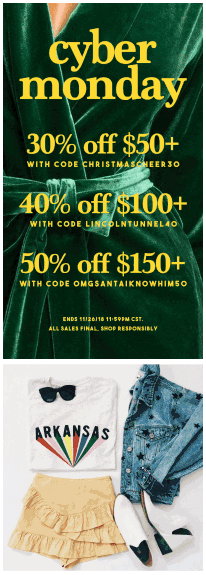
Follow the same tips as Black Friday, but also see examples of good Cyber Monday campaigns to get some ideas for your marketing efforts.
Riffraff makes good use of GIFs to catch people’s attention and clearly promote both their special offers and some of their product range.
The great thing about GIFs is that they are easy to consume!
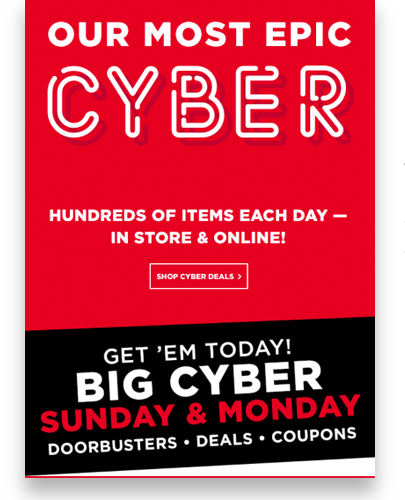
Michaels make themselves stand out with an ad that boasts of not just Cyber Monday sales, but a Cyber Sunday too! Don’t be afraid to try something different to make your brand stand out from the crowd.
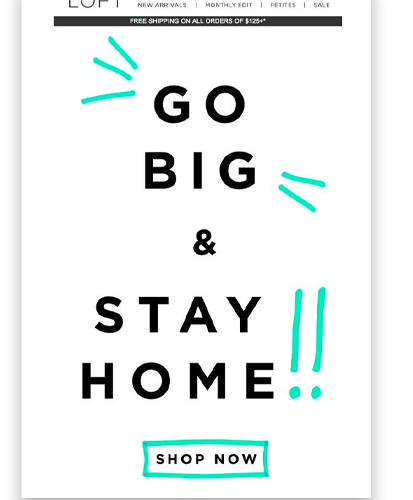
Cyber Monday is all about getting those good deals from the comfort of your own home.
Make the idea of staying at home seem appealing and highlight the convenience of online shopping by using clever, yet simple wording like the LOFT example here.
The number one tip we can give you is – DON’T PANIC!
Ecommerce retailers feel pressured to make BFCM go with a bang and all-too-often rush into crazy deep discounts or blanket offers that aren’t profitable by the time you factor in the high advertising costs.
Slow down. Even if you’ve only got a few weeks or days left – you can still come up with a profitable campaign and offer!
Yes, you want to stand out and create a buzz, but not at the expense of your bottom line. If you follow the advice laid out above and plan a marketing strategy that is based on good business sense combined with creativity, you won’t go too far wrong!
Black Friday and Cyber Monday are the run-up events to Christmas, but don’t forget that the first few weeks of December is an excellent opportunity to boost sales too.
Here are some ideas to maximize sales during this period:
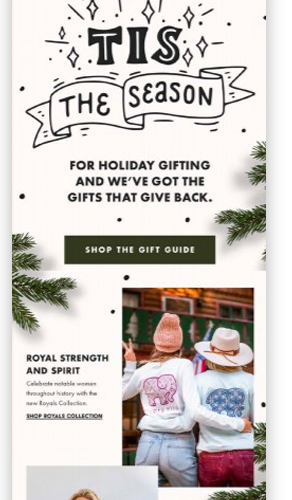
This email shows how eCommerce company Ivory Ella made the most of the holiday season to promote its gift guide in a fun and engaging way, using a 12 days of Christmas theme.

Online shopping is experiencing a golden age right now.
Covid-19 has accelerated the growth of eCommerce even further, with more and more people preferring to shop in the comfort and safety of their own home.
This has led to an increase in competition however, with higher ad costs.

This means that you need to use smart-marketing ideas to complement any paid ad campaigns. You cannot just rely on posting a few Facebook ads and expecting good traffic as you may have done in past holiday seasons.
Despite the challenges, holiday seasons present some of the best online sales opportunities ever for those that get their marketing right.
To finish up, here are a few “quick-wins” that you can get to work on now to get your holiday marketing moving:

As you can see, there’s a lot that goes into planning & running a SUCCESSFUL holiday marketing campaign! But it’s never too late, with the right support!
Want a hand with your holiday marketing, or prefer a team who will create a holiday marketing campaign customized to your business? In either case, let’s chat!
A Lot To Take In?
Download a Checklist!
There's a lot to your holiday marketing campaigns.
Download our cheat sheet checklist & make your life easier!